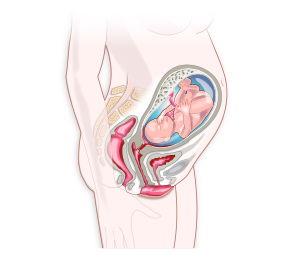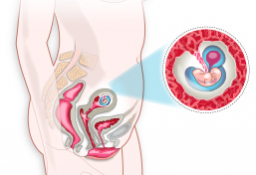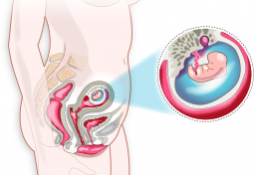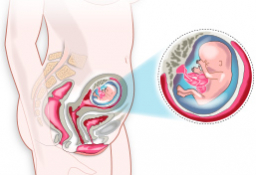Changes in the sixth month of pregnancy
The mother-to-be’s back curves to compensate for the belly
During the sixth month, the pregnancy is very evident. Due to the growth of the uterus, the mum-to-be may experience digestive problems, such as heartburn or backache
Changes in the mother
By the sixth month, most of the symptoms of the first trimester have probably gone. The size of the belly is already obvious to everyone and the movements of the foetus are noticed every day.
The breasts have increased up to three times their normal size and the areolas are increasingly larger and darker. Small lumps may appear. The linea nigra (a line that runs from the pubic bone to above the navel) becomes more evident because of the increased melanin in the area.
There is an increase in blood volume, which reduces the proportion of red blood cells in the blood and with it the levels of iron. Anaemia is therefore quite a common condition. The heart rate also rises which, together with the increase in blood volume, produces an increase in palpitations.
Hormonal changes can still cause psychological disorders, such as sudden mood swings.
Physical changes
- The uterus is now above the belly button, which causes discomfort in the pubis and around the ribs. This growth of the uterus puts pressure on different parts of the body, such as the stomach, producing heartburn and reflux, on the intestines, producing gas, flatulence and constipation and on the bladder, producing infections and an increase in the urge to urinate.
- As the uterus grows, so does the belly, causing the skin to stretch, which leads to the appearance of stretch marks, discomfort and itching in the area.
- There is a feeling of clumsiness because the size of the belly begins to shift the body's centre of gravity forward. To compensate for this change, the curve of the lumbar spine curve becomes more exaggerated. This phenomenon is called hyperlordosis or “hollow back”.
- At the end of this month, the average weight gain is between 5 and 7 kg.
Anaemia in pregnancy
At this stage of pregnancy, it is possible to suffer from anaemia, one of the most frequent complications for pregnant women. Learn how to eat an iron-rich diet to avoid it.
Changes in the baby in the sixth month of pregnancy
- The foetus reaches 32-34 cm and weighs between 800 and 1,000 g.
- Its skin is still wrinkled and thin, but it has many facial expressions: it puts its tongue out, it yawns, it smiles, it opens its eyes, etc.
- Its five senses are already developed, it touches different parts of its body and the walls of the uterus, it swallows amniotic fluid for the formation of the taste buds, it begins to hear and differentiate sounds. It is also able to discern the faint light that gets through the thick walls of the womb.
- The colour of the eyes is not fully developed and may change in the first few weeks after birth.
- The foetus has its cycles. It will spend long periods of time sleeping without moving and periods awake, its movements being more evident daily. It changes position several times a day, spins, turns and kicks because the amniotic space is still very spacious. You can even feel its hiccups in the form of spasms, the lack of air in its lungs prevents them from generating sound. Hiccups are a sign of foetal well-being, so if you notice them you don’t need to worry.










